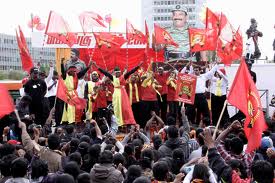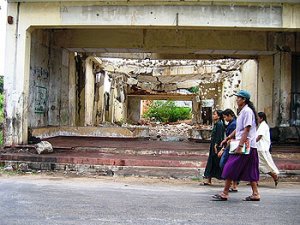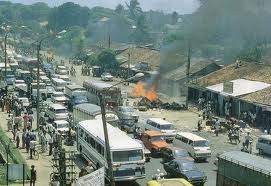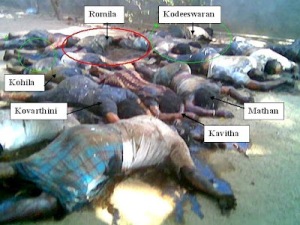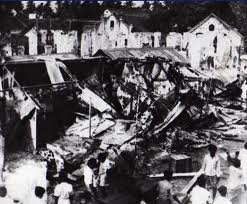Dambulla and Black July:Not just anti-terrorism against the LTTE
 Muslim in Sri Lanka are quite a distinct case. Unlike Tamils and Sinhalese, they never made any claim of sovereignty in the island. But they found themselves harshly hit by the civil war. They suffered ethnic cleansing in the Norther Provinces by the LTTE and complete oblivion by the Sri Lankan government as refugees.
Muslim in Sri Lanka are quite a distinct case. Unlike Tamils and Sinhalese, they never made any claim of sovereignty in the island. But they found themselves harshly hit by the civil war. They suffered ethnic cleansing in the Norther Provinces by the LTTE and complete oblivion by the Sri Lankan government as refugees.
In Puttalam more than 100 000 people have been forgotten in refugee camps for 20 years. As recent as in 2009 the UNCHR (the United Nations agency for refugees), in partnership with Brandix Lanka were still struggling to deliver basic needs, like water and sanitation to them.
 The Muslim in the Northern Provinces were Tamil speakers and lived in the region since hundreds of years. Their presence in modern times is old as the ones of Tamil or Sinhalese; yet they were considered stranger by the LTTE, on the main ground that they weren’t ‘real’ Tamils. If it was necessary, an evidence more of LTTE’s lack of democratic and inclusive conscience.
The Muslim in the Northern Provinces were Tamil speakers and lived in the region since hundreds of years. Their presence in modern times is old as the ones of Tamil or Sinhalese; yet they were considered stranger by the LTTE, on the main ground that they weren’t ‘real’ Tamils. If it was necessary, an evidence more of LTTE’s lack of democratic and inclusive conscience.
On the other side as well, Colombo showed its absolute disinterest for any other ethnic group outside the Sinhalese. During the IV Eelam War, Muslims parties have orbited around president Rajapaksa, on the ground that as a minority, it was better to cooperate rather than contest the majoritarian force of the central government. In the present coalition of government, Sri Lankan Muslims are present as ministers, but this compromise seems shor-lived.
 The supremacist Sinhalese sentiment is growing stronger also against the Muslims. In April, radical Buddhists have tried to demolish the mosque of Dambulla. They fire-stormed the mosque and they threatened 70 others buildings of cult.
The supremacist Sinhalese sentiment is growing stronger also against the Muslims. In April, radical Buddhists have tried to demolish the mosque of Dambulla. They fire-stormed the mosque and they threatened 70 others buildings of cult.
The monks involved in the protest claimed that they are just protecting Buddhism from encroachment, but everyone knows that all the other religions on the island are quite low-profile and don’t dare to contest the dominant position of the Buddhism. The minorities only try to survive in a climate of mistrust and oppression.
 It is significative that the government is placidly turning its eyes somewhere else, when these cases of hatred and violence erupt. In a state where authoritarian rule is based on the iron-fist of the army, you may wonder how episodes of anarchy can take place. The reason is always the same: from the communal riots of ’58 and ’83, the government is implicitly backing up the racist-driven unrest.
It is significative that the government is placidly turning its eyes somewhere else, when these cases of hatred and violence erupt. In a state where authoritarian rule is based on the iron-fist of the army, you may wonder how episodes of anarchy can take place. The reason is always the same: from the communal riots of ’58 and ’83, the government is implicitly backing up the racist-driven unrest.
All the the rhetoric of the Sri Lankan state is dedicated towards a unitarian entity, but in any possible occasion it is remarked that unity Sri Lanka is Sinhalese and Buddhist. Consequently all the other minorities should consider themselves as barely tolerated.
The reality in the island is an intense hatred of the minorities by the majority. Sometimes this underground sentiment surfaces and explodes in violence. But the government is far from trying to reign it. On the contrary it deliberately let the steam off as a measure of control and threaten of the minority.
 The LTTE was responsible for heinous crime, but the war was not anti-terrorism. The Tigers desperately tried to resist a force of discrimination and oppression, a violent force with the secret intent of eliminating and wiping out all the outsiders of the Sinhalese mainstream.
The LTTE was responsible for heinous crime, but the war was not anti-terrorism. The Tigers desperately tried to resist a force of discrimination and oppression, a violent force with the secret intent of eliminating and wiping out all the outsiders of the Sinhalese mainstream.
Until Sri Lanka will come to terms of the diversity within itself, an underlying resentment of the other minorities will be kept alive for further challenges of this unjust authority.


